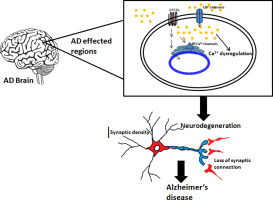当前位置:
X-MOL 学术
›
Mol. Cell. Neurosci.
›
论文详情
Our official English website, www.x-mol.net, welcomes your feedback! (Note: you will need to create a separate account there.)
Role of GPCR signaling and calcium dysregulation in Alzheimer's disease.
Molecular and Cellular Neuroscience ( IF 3.5 ) Pub Date : 2019-10-23 , DOI: 10.1016/j.mcn.2019.103414 Sushma 1 , Amal Chandra Mondal 1
Molecular and Cellular Neuroscience ( IF 3.5 ) Pub Date : 2019-10-23 , DOI: 10.1016/j.mcn.2019.103414 Sushma 1 , Amal Chandra Mondal 1
Affiliation

|
Alzheimer's disease (AD), a late onset neurodegenerative disorder is characterized by the loss of memory, disordered cognitive function, caused by accumulation of amyloid-β (Aβ) peptide and neurofibrillary tangles (NFTs) in the neocortex and hippocampal brain area. Extensive research has been done on the findings of the disease etiology or pathological causes of aggregation of Aβ and hyperphosphorylation of tau protein without much promising results. Recently, calcium dysregulation has been reported to play an important role in the pathophysiology of AD. Calcium ion acts as one of the major secondary messengers, regulates many signaling pathways involved in cell survival, proliferation, differentiation, transcription and apoptosis. Calcium signaling is one of the major signaling pathways involved in the formation of memory, generation of energy and other physiological functions. It also can modulate function of many proteins upon binding. Dysregulation in calcium homeostasis leads to many physiological changes leading to neurodegenerative diseases including AD. In AD, GPCRs generate secondary messengers which regulate calcium homeostasis inside the cell and is reported to be disturbed in the pathological condition. Calcium channels and receptors present on the plasma membrane and intracellular organelle maintain calcium homeostasis through different signaling mechanisms. In this review, we have summarized the different calcium channels and receptors involved in calcium dysregulation which in turn play a critical role in the pathogenesis of AD. Understanding the role of calcium channels and GPCRs to maintain calcium homeostasis is an attempt to develop effective AD treatments.
中文翻译:

GPCR信号转导和钙失调在阿尔茨海默氏病中的作用。
阿尔茨海默氏病(AD)是一种迟发性神经退行性疾病,其特征在于记忆力丧失,认知功能障碍,这是由于新皮层和海马脑区中的淀粉样β(Aβ)肽和神经原纤维缠结(NFT)积累引起的。已经对Aβ聚集和tau蛋白过度磷酸化的疾病病因或病理原因的发现进行了广泛的研究,但没有太多有希望的结果。最近,据报道钙失调在AD的病理生理中起重要作用。钙离子充当主要的次要信使之一,调节涉及细胞存活,增殖,分化,转录和凋亡的许多信号通路。钙信号传导是参与记忆形成的主要信号传导途径之一,产生能量和其他生理功能。结合后它还可以调节许多蛋白质的功能。钙稳态的失调导致许多生理变化,从而导致包括AD在内的神经退行性疾病。在AD中,GPCR产生二级信使,调节细胞内的钙稳态,据报道其在病理状态中受到干扰。存在于质膜和细胞内细胞器上的钙通道和受体通过不同的信号传导机制维持钙稳态。在这篇综述中,我们总结了钙异常调节中涉及的不同钙通道和受体,它们在AD的发病机理中起着至关重要的作用。
更新日期:2019-10-23
中文翻译:

GPCR信号转导和钙失调在阿尔茨海默氏病中的作用。
阿尔茨海默氏病(AD)是一种迟发性神经退行性疾病,其特征在于记忆力丧失,认知功能障碍,这是由于新皮层和海马脑区中的淀粉样β(Aβ)肽和神经原纤维缠结(NFT)积累引起的。已经对Aβ聚集和tau蛋白过度磷酸化的疾病病因或病理原因的发现进行了广泛的研究,但没有太多有希望的结果。最近,据报道钙失调在AD的病理生理中起重要作用。钙离子充当主要的次要信使之一,调节涉及细胞存活,增殖,分化,转录和凋亡的许多信号通路。钙信号传导是参与记忆形成的主要信号传导途径之一,产生能量和其他生理功能。结合后它还可以调节许多蛋白质的功能。钙稳态的失调导致许多生理变化,从而导致包括AD在内的神经退行性疾病。在AD中,GPCR产生二级信使,调节细胞内的钙稳态,据报道其在病理状态中受到干扰。存在于质膜和细胞内细胞器上的钙通道和受体通过不同的信号传导机制维持钙稳态。在这篇综述中,我们总结了钙异常调节中涉及的不同钙通道和受体,它们在AD的发病机理中起着至关重要的作用。



























 京公网安备 11010802027423号
京公网安备 11010802027423号